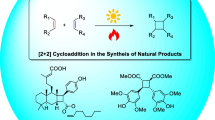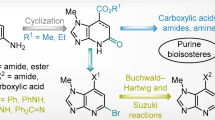Abstract
4,4-Dimethyloxazolones derived from N-protected aminoisobutyric acid (AIB) are particularly known as poor electrophiles due to the steric hindrance around the carbonyl and not employed as useful intermediates for amidation whereas numerous examples have been reported to support the utility of other oxazolones in amidation. AIB is an important and strategical synthon in medicinal chemistry but the peptide bond formation of the N-protected urethane derivatives of AIB is known to be often unproductive due to the rapid formation of the stable 4,4-dimethyloxazolone via an intramolecular cyclization. We discovered that the 4,4-dimethyloxazolone of an AIB urethane is in fact an excellent electrophile that enables efficient amidation even with weakly reactive nucleophiles. The 4,4-dimethyloxazolone can be stored in a pure form and used as a reagent offering an efficient and convenient synthetic tool for generating AIB-peptide analogs.
Graphical Abstract











Similar content being viewed by others
References
Brown ZZ, Schafmeister CE (2008) Exploiting an inherent neighboring group effect of α-amino acids to synthesize extremely hindered dipeptides. J Am Chem Soc 130:14382–14383
Chen X, Turecek F (2005) Simple b ions have cyclic oxazolone structures. A neutralization–reionization Mass spectrometric and computational study of oxazolone radicals. J Am Soc Mass Spectrom 16:1941–1956
Frydman-Marom A, Convertino M, Pellarin R, Lampel A, Shaltiel-Karyo R, Segal D, Caflisch A, Shalev DE, Gazit E (2011) Structural basis for inhibiting β-amyloid oligomerization by a non-coded β-breaker-substituted endomorphin analogue. ACS Chem Biol 6:1265–1276
Hansen JDW, Mazur RH, Pilipauskas DR (1986) Substituted tyrosyl alanine dipeptide amides. US 4599325
Henninot A, Collins JC, Nuss JM (2018) The current state of peptide drug discovery: back to the future? J Med Chem 61:1382–1414
Hroch L, Hrušková M, Schmitz J, Schnakenburg G, Gütschow M (2012) 3,5,5-trisubstituted hydantoins from activated (Benzyloxycarbonylamino)malonic acids. Synthesis 44:1907–1914
Humphrey JM, Chamberlin AR (1997) Chemical synthesis of natural product peptides: coupling methods for the incorporation of noncoded amino acids into peptides. Chem Rev 97:2243–2266
Jo M, Won SW, Lee DG, Jung JK, Kim S, Kwak YS (2018) An efficient synthetic protocol for amide derivatives of Boc-2-aminoisobutyrate. Arch Pharmacal Res 41:259–264
Kaneti J, Kirby AJ, Koedjikov AH, Pojarlieff IG (2004) Thorpe-Ingold effects in cyclizations to five-membered and six-membered rings containing planar segments. The rearrangement of N (1)-alkyl-substituted dihydroorotic acids to hydantoinacetic acids in base. Org Biomol Chem 2:1098–1110
Nakajima K, April M, Brewer JT, Daniels T, Forster CJ, Gilmore TA, Jain M, Kanter A, Kwak Y, Li J (2016) Discovery of diamide compounds as diacylglycerol acyltransferase 1 (DGAT1) inhibitors. Bioorg Med Chem Lett 26:1245–1248
Pekary AE (2013) Handbook of biologically active peptides, 2nd edn. Elsevier, New York, pp 951–956
Plucińska K, Liberek B (1987) Synthesis of diazoketones derived from α-amino acids; problem of side reactions. Tetrahedron 43:3509–3517
Priepke HD, Georg, Gerlach K, Pfau R, Wienen W, Schuler-Metz A, Handschuh S, Nar H (2007) Neue substituierte Glycinamide, deren Herstellung und deren Berwendung als Arzneimittel. PCT WO 2007/003536 A1
Savage SAD, Nathan R, Mack B, Vemishetti P, Qiu Y, Fenster M, Hallow DM, Ferreira G, Rogers A, Lou S, Hobson L (2015) Hepatitis C virus inhibitors cross-referenece to related applications. PCT WO 2015200305
Wieland T, Bodanszky M (2012) The world of peptides: a brief history of peptide chemistry. Springer, Berlin
Xu Z, Liu L, Wheeler K, Wang H (2011) Asymmetric inverse-electron-demand hetero-Diels–Alder reaction of six-membered cyclic ketones: an enamine/metal Lewis acid bifunctional approach. Angew Chem 123:3546–3550
Acknowledgements
This research was supported by the Basic Research Program through the National Research Foundation of Korea (NRF) funded by the Ministry of Education, Science and Technology (NRF-2015R1A2A2A04003471).
Author information
Authors and Affiliations
Corresponding author
Ethics declarations
Conflict of interest
The authors declare that they have no conflict of interest.
Electronic supplementary material
Below is the link to the electronic supplementary material.
Rights and permissions
About this article
Cite this article
Jo, M., Won, SW., Lee, D.G. et al. Facile ring opening reaction of oxazolone enables efficient amidation for aminoisobutyric acid. Arch. Pharm. Res. 41, 481–489 (2018). https://doi.org/10.1007/s12272-018-1031-5
Received:
Accepted:
Published:
Issue Date:
DOI: https://doi.org/10.1007/s12272-018-1031-5




